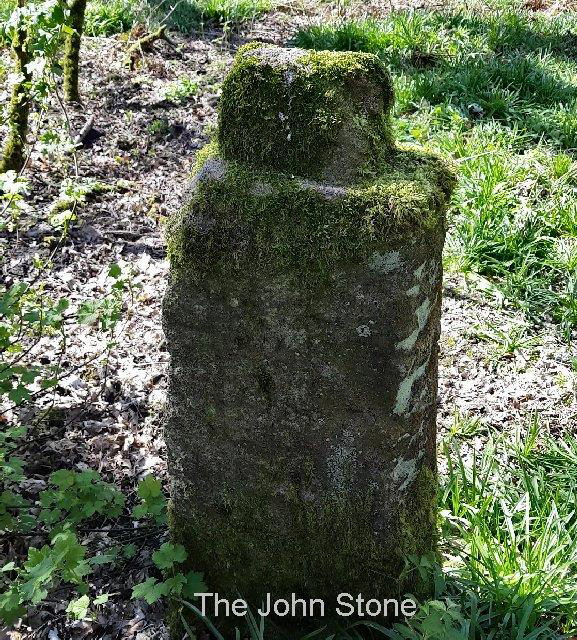
We first became aware of these enigmatic stones when studying the possibility of a Roman road linking Wigan with Ribchester. In 2018 we paid a visit to Heapey Fold Lane on Healey Nab (reported on our blog here) as this seemed to be the prime candidate for the route. We were trying to find the site of an excavation carried out by Chorley Arch Soc in the 1960s. Jack Smith, then member of the dig team, described the location as being near one of these stones. We didn't locate the site of the dig but we find the post mentioned by Jack. At the time I didn't think much of it (just assumed it was some commonly found feature on gateposts). A couple of months ago Chris Drabble asked me if I knew anything about The John Stone in Duxbury Park near where he lives. He described it as an upright stone looking like a gatepost but without any fittings and had a strange tenon shape on top. When I mentioned the similar post on Healey Nab, it set him off looking into these strange features and he found more details on the internet. A report by Ian Barrow in the Leyland Historical Society's 2003 Chronicle (issue 49 p.28), described in detail his search for these enigmatic features (a version now available on his Lancashire Antiquarian blog). Ian was informed of the location of 30 or more in the general Leyland area but only managed to find 18 himself. His information came from members of the Leyland Society and Chorley Arch Soc. In fact it is likely that it came from Jack Smith who says that the Chorley Society first started studying these features a decade earlier (he even wrote an article for their bulletin at the time). In the meantime Chris has been searching and has discovered over a dozen himself. The greatest concentration seems to be around Brindle, but he's found some as far as Longton in the West and even as far as the Fylde in the north (where Wyre Arch Soc have found one at Brock Bottoms).
The question remains however, how old are they and what were they for. They are generally well weathered with lichen growing on them and usually a single post with no fittings (which belies their name as gateposts). One suggested theory supported by both Jack and Chris, is that they date from the Catholic repressions of the early 17th century. Brindle has a strong recusant history and many "unlawful meetings of Papist" were held in Mass houses there. This activity revolved around Edmund Arrowsmith who was executed at Lancaster Castle in 1628 as one of the Forty Martyrs of England and Wales. He also ministered to the Catholics at Mass houses in the Whittle-le-Woods and Leyland areas. This was a secretive activity, with Arrowsmith only mentioning where he would next hold Mass close to the event. Catholic recusants often had ways of signalling to each other where Mass would be held next (washing on hedges for example). Could the posts have been used, maybe with a temporary wooden socketed beam placed on top to make the rough shape of a cross, as a sign as to where and when the next Mass would be held?
The posts are also found outside the Brindle area, so could there be another explanation. Many are situated on, or near to significant boundaries and Chris sees a correlation with lands held by Penwortham Priory, Cockersands Abbey, the Knights of St John Hospitallers and Royalist areas in the 17th century. This brings us back to The John Stone which is located in John Wood next to John field - the Knights of St John did have lands in this part of Duxbury. Chris has surveyed the area and using LiDAR has discovered a ditch running past the stone as well as a hidden trackway, 3m wide, that runs across the slope. Parts of this slope have eroded and, as the trackway doesn't appear on any OS or estate map, it suggests it has some age. Chris intends to continue his searches for more stones and will plot his findings on his GIS map, in a hope that he can get to the bottom of these features and in particular The John Stone.
High Riders to Rolls Royces
The story of Timberlakes of Wigan was the subject of Jim Meehan's talk to the WLHHS last month. This is now available on YouTube. If watch it, at the end you will notice that Jim got access to the old Timberlake buildings, which revealed some of the original features e.g. a 110 year old car lift mechanism. We've always intended doing a build survey at some point and this build would make a great subject. Let me know if you'd like to get involved.
Next Meeting
We are hoping to have our first meeting out of lockdown on Wednesday 4th August (7.30pm as usual). The meeting will be held at Real Crafty on Upper Dicconson Street where we held our recent committee meeting. It seems quite suitable for our needs as it has a large back room, its own car park with plenty street parking nearby and, not least, decent ale. This meeting will be our delayed AGM but we will also be having a presentation on the projects we've undertaken (mainly on-line) over the last 12 months.
Hope to see you then. B.A.
|



